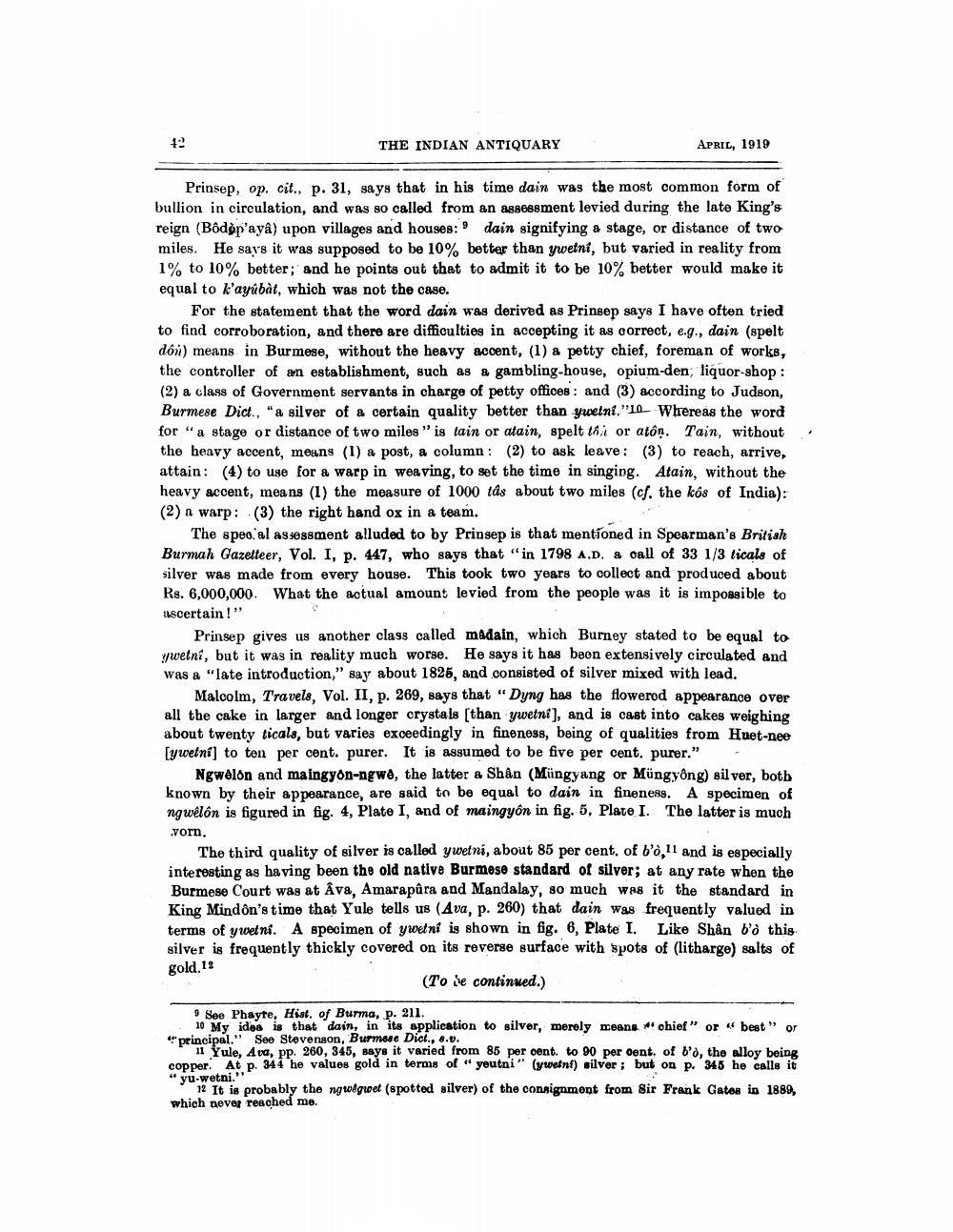________________
THE INDIAN ANTIQUARY
APRIL, 1919
Prinsep, op. cit., p. 31, says that in his time dain was the most common form of bullion in circulation, and was so called from an assessment levied during the late King's reign (Bôdon'aya) upon villages and houses: 9 dain signifying a stage, or distance of two miles. He says it was supposed to be 10% better than ywetní, but varied in reality from 1% to 10% better; and he points out that to admit it to be 10% better would make it equal to k'ayúbàt, which was not the case.
For the statement that the word dain was derived as Prinsep says I have often tried to find corroboration, and there are difficulties in accepting it as correct, e.g., dain (spelt dón) means in Burmese, without the heavy accent, (1) a petty chief, foreman of works, the controller of an establishment, such as a gambling-house, opium-den, liquor-shop: (2) a class of Government servants in charge of petty offices: and (3) according to Judson, Burmese Dict., "a silver of a certain quality better than yweini."10. Whereas the word for "a stage or distance of two miles" is tain or atain, spelt thi or atón. Tain, without the heavy accent, means (1) a post, a column: (2) to ask leave: (3) to reach, arrive, attain: (4) to use for a warp in weaving, to set the time in singing. Atain, without the heavy accent, means (1) the measure of 1000 tds about two miles (cf. the kos of India): (2) a warp: (3) the right hand ox in a team.
The speo, al assessment alluded to by Prinsep is that mentioned in Spearman's British Burmah Gazetteer, Vol. I, p. 447, who says that "in 1798 A.D. & call of 33 1/3 ticals of silver was made from every house. This took two years to collect and produced about Rs. 6,000,000. What the actual amount levied from the people was it is impossible to ascertain !"
Prinsep gives us another class called madain, which Burney stated to be equal to ywetni, but it was in reality much worse. He says it has been extensively circulated and was a "late introduction," say about 1825, and consisted of silver mixed with lead.
Malcolm, Travels, Vol. II, p. 269, says that “Dyng has the flowerod appearance over all the cake in larger and longer crystals (than ywetni), and is cast into cakes weighing about twenty ticals, but varies exceedingly in fineness, being of qualities from Huet-nee (ywetní) to ten per cent. purer. It is assumed to be five per cent. purer."
Ngwelon and maingyon-ngwe, the latter a Shân (Müngyang or Müngyông) silver, both known by their appearance, are said to be equal to dain in fineness. A specimen of ngwelón is figured in fig. 4, Plate I, and of maingyôn in fig. 5, Plate I. The latter is much .vorn.
The third quality of silver is called ywetni, about 85 per cent, of b'o.11 and is especially interesting as having been the old native Burmese standard of silver; at any rate when the Burmese Court was at Åva, Amarapara and Mandalay, so much was it the standard in King Mindôn's time that Yule tells us (Ava, p. 260) that dain was frequently valued in terms of ywelni. A specimen of ywetni is shown in fig. 6, Plate I. Like Shân b'd this silver is frequently thickly covered on its reverse surface with spots of (litharge) salts of gold.12
(To be continued.)
9 See Phayte, Hist. of Burma, p. 211.
10 My idea is that dain, in its application to silver, merely means ohief" or "best" or principal." See Stevenson, Burmese Dict., 8.0.
11 Yule, Ava, pp. 260, 345, says it varied from 85 per cent. to 90 per cent. of b'd, the alloy being copper. At p. 344 he values gold in terms of " yeutni" (ywelné) silver ; but on p. 345 he calls it
12 It is probably the ng wagwet (spotted silver) of the consignment from Sir Frank Cates in 1889, which never reached me.
"yu-wetni."




